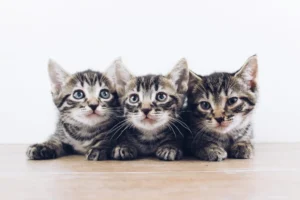Blue jays are known for their bold and aggressive nature, and one of their common targets for aggression is cats. Many cat owners have witnessed blue jays swooping down and attacking their furry companions, but why exactly do these birds act this way? Let’s explore the reasons behind this behavior and dive into the fascinating world of blue jays and cats.
Blue jays attack cats due to territorial instincts, protecting their nests, and defending themselves. These birds see cats as potential predators or threats to their offspring, prompting them to display aggressive behaviors in response. Understanding this dynamic can help pet owners navigate interactions between their cats and these feisty birds.
Territorial Instincts
Blue jays are territorial creatures by nature, fiercely protecting their space from any perceived threats. When a blue jay spots a cat in its territory, it sees an intruder encroaching on its domain. This triggers the blue jay’s defensive instincts, prompting it to attack the feline to drive it away.
In the eyes of a blue jay, cats are unwelcome guests that pose a risk to the bird’s safety and well-being. The blue jay sees the cat as a potential predator capable of harming it, so it takes a proactive approach to defend itself. This territorial behavior explains why blue jays may act aggressively towards cats in their vicinity.
It is essential to understand that for a blue jay, protecting its territory is a matter of survival. By recognizing and respecting the territorial instincts of these birds, pet owners can take steps to prevent confrontations between blue jays and cats, ensuring the safety of both species.
Nest Protection
When it comes to their nests and offspring, blue jays become even more vigilant and defensive. These birds view cats as potential threats to their precious eggs and young chicks, triggering their protective instincts to kick into high gear. A cat lurking near a blue jay’s nest is akin to waving a red flag in front of a bull – it’s a recipe for trouble.
Blue jays go to great lengths to shield their nests from harm, including launching aggressive attacks on any perceived intruders like cats. For a blue jay, the safety of its offspring is paramount, and it will stop at nothing to ward off any dangers that come too close.
In light of this, pet owners should be mindful of the presence of blue jay nests in their vicinity and take precautions to protect them from potential threats. By creating a safe environment for these birds to raise their young, we can help minimize conflicts between blue jays and cats while fostering a harmonious coexistence in our shared spaces.
Self-Defense Mechanisms
Blue jays are known for their feisty nature and strong self-defense mechanisms that help them survive in the wild. When it comes to facing potential threats like cats, blue jays rely on their sharp beaks and agile flying skills to ward off danger. Aggression is a key component in their survival toolkit, as they fearlessly defend their territory and nest from any perceived threats. These birds are fiercely protective of their young and will not hesitate to attack any intruders, including cats, if they feel their young are in danger. So, it’s not surprising that blue jays may seem aggressive towards cats in defense of their own.
Cat Behavior Triggers
Understanding the common behaviors exhibited by cats can shed light on why blue jays may see them as targets. Cats are curious creatures by nature, and their hunting instincts often kick in when they spot small, fast-moving animals like birds. Stalking, pouncing, and chasing are all typical behaviors that might trigger a blue jay’s defensive response. Additionally, cats’ stealthy movements and sudden attacks can startle and provoke blue jays, leading to clashes between these two animals. It’s essential for cat owners to be aware of their pets’ behaviors around birds like blue jays to prevent any potential conflicts.
Blue Jays Love Shiny Objects
One interesting fact about blue jays that can contribute to their confrontations with cats is their affinity for shiny objects. Blue jays have been known to steal and hoard small, shiny items like jewelry or coins, which can catch the attention of curious cats. This behavior may inadvertently lead to interactions between blue jays and cats, especially if a cat is intrigued by the glittering objects in a blue jay’s possession. Be mindful of this quirky habit of blue jays, as it may play a role in their interactions with cats.
Deterrent Strategies
Blue jays can become territorial when they perceive cats as a threat to their young or food sources. To deter blue jays from targeting your feline friends, consider placing shiny objects like wind chimes or CDs near areas frequented by the birds. Additionally, providing ample food and water for the blue jays away from where your cats roam can help redirect their attention. Planting shrubs or bushes for your cats to hide in can also create safe spaces. Lastly, supervising your cat’s outdoor activities can help prevent potential attacks.
Unique Insight: Installing a birdbath or fountain in your backyard can attract blue jays away from your cats, as they are drawn to water sources.
Impact on Cats
When faced with blue jay attacks, cats may experience physical injuries like scratches or bites. Psychologically, repeated attacks can cause stress and anxiety in cats, affecting their overall well-being. To support your pet, ensure they have a safe indoor space where they can retreat if needed. Monitor their behavior for any signs of distress or discomfort following an attack. Providing enrichment activities like interactive toys can help alleviate stress and keep cats mentally stimulated.
Remember, a calm environment and consistent routines can reassure your cat and help them feel secure.
External Resource: American Society for the Prevention of Cruelty to Animals (ASPCA) – Provides guidance on caring for pets and handling stressful situations.
Human Intervention
Blue jays are known to be protective of their territory, often viewing cats as potential threats to their nests and young. As pet owners, it’s essential to understand this dynamic and take proactive steps to mediate any conflicts that may arise. One effective solution is to create a designated outdoor area for your cat, such as a catio, where they can enjoy the outdoors safely without encroaching on the territory of blue jays. By providing a separate space for your cat, you can help minimize the chances of confrontations with these territorial birds, ultimately fostering a more peaceful coexistence between cats and blue jays.
Additionally, educating yourself on the behaviors of both cats and blue jays can also help prevent conflicts. Understanding the natural instincts of these animals can guide you in implementing measures to reduce potential triggers for aggression. By being attentive to your surroundings and mindful of the interactions between your cat and blue jays, you can play a proactive role in promoting harmony between these two species.
For further information on how to create a cat-friendly outdoor space to prevent conflicts with blue jays, you can explore the comprehensive guide provided by the American Society for the Prevention of Cruelty to Animals (ASPCA) on “Outdoor Enrichment for Cats” ASPCA Outdoor Cat Enrichment Guide
Interesting Facts
Did you know that blue jays are highly intelligent birds known for their exceptional memory and problem-solving skills? These clever creatures are capable of mimicking the calls of other bird species and have been observed using tools to obtain food. Their distinctive blue plumage and vibrant personalities make them a favorite among birdwatchers.
Another fascinating fact about blue jays is their complex social hierarchy within their flocks. These birds exhibit dominance hierarchies, with individuals establishing their rank through displays of aggression and vocalizations. Understanding the intricate social dynamics of blue jays sheds light on their behaviors towards other animals, such as cats, as they seek to protect their territory and ensure the safety of their young.
By appreciating the intelligence and social structures of blue jays, we can gain a deeper insight into why they may perceive cats as potential threats and act defensively. This knowledge can empower pet owners to take proactive measures to prevent conflicts and promote a harmonious environment for both cats and blue jays to coexist peacefully.
Alex, a passionate animal lover, has experience in training and understanding animal behavior. As a proud pet parent to two dogs and three cats, he founded AnimalReport.net to share insights from animal experts and expand his knowledge of the animal kingdom.









